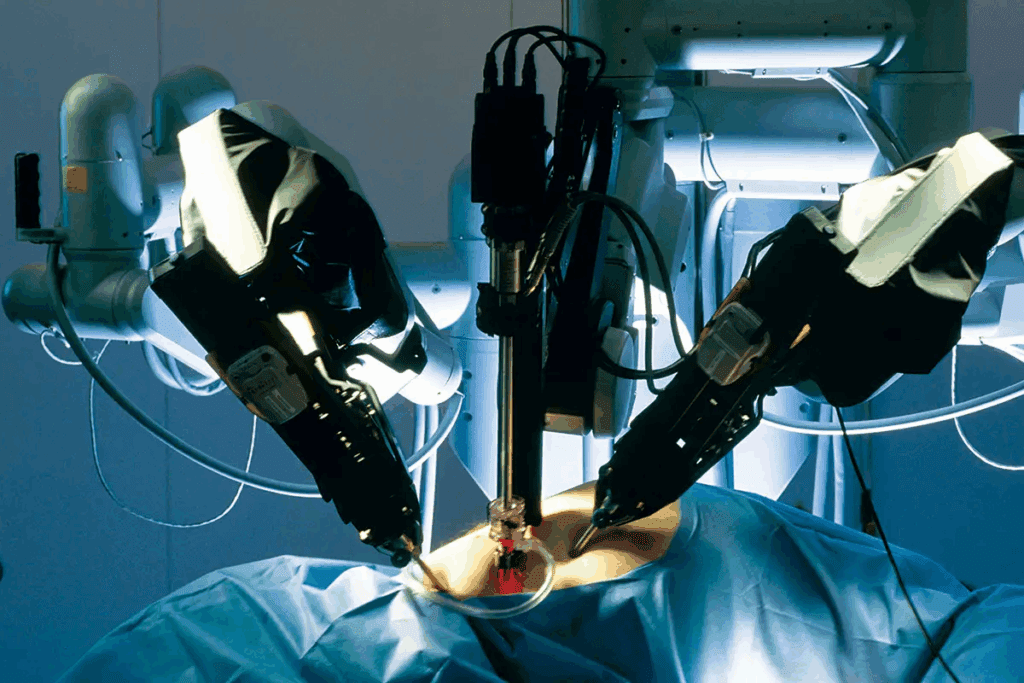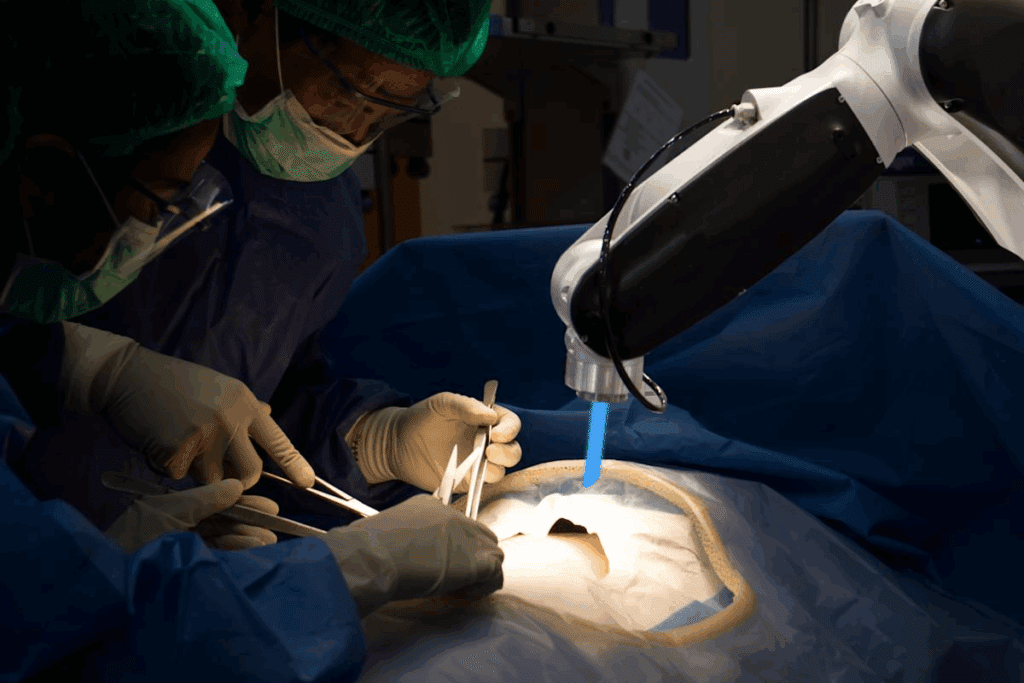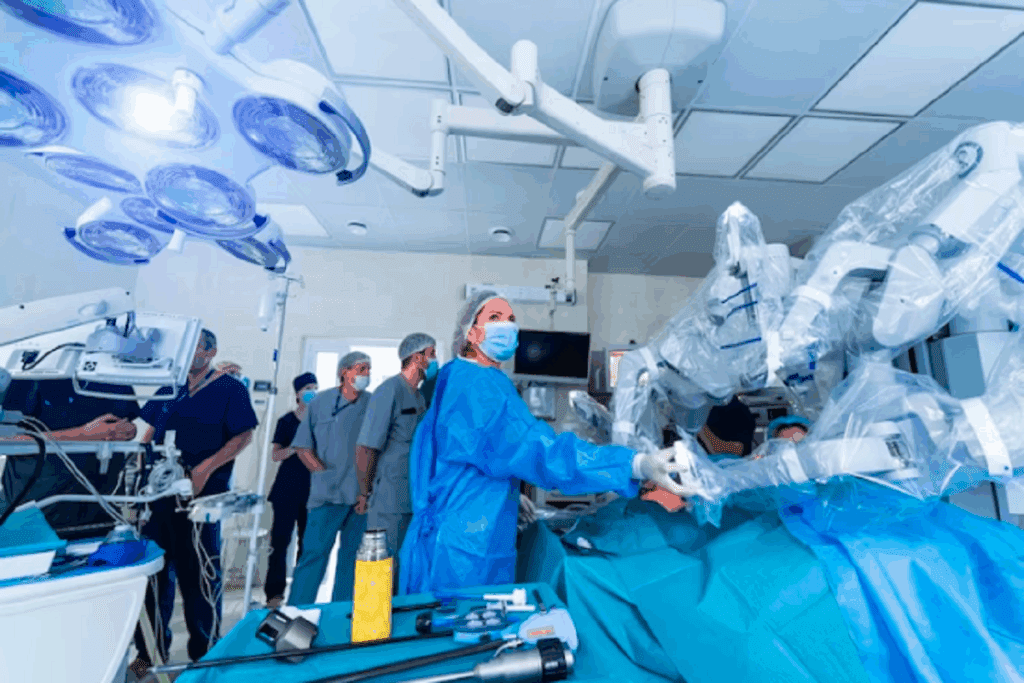Last Updated on November 27, 2025 by Bilal Hasdemir

The latest in medical tech has brought us cutting-edge surgical technology. It’s changing surgery for the better. What is the Newest Surgical Robot system to hit the operating room? Discover the amazing technology and its positive impact on patients.
Systems like the da Vinci Surgical System and Medtronic’s Hugo RAS System are making a big difference. They give surgeons better precision and control.
These advanced medical robotics make surgeries less invasive. This means less harm to patients and quicker healing times.

The evolution of surgical robotics has changed modern medicine a lot. It has made surgeries better. This change came from new technology and the need for more precise and less invasive surgeries.
The move from manual surgery to robotic-assisted procedures has seen big steps forward. Early surgeries depended a lot on the surgeon’s skill, with limits in precision and access. Robotic systems have fixed these problems, bringing enhanced visualization, precision, and control.
Robotic help in surgery makes complex procedures easier and more accurate for surgeons. It also means patients recover faster and have better results.
The growth of surgical robotics has hit many important milestones. A big one was the da Vinci Surgical System. It changed laparoscopic surgery by making it more intuitive and precise.
These steps forward in advanced surgical robotics have changed the field a lot. They let surgeons do more complex surgeries with better precision and less invasiveness. As the field keeps growing, we’ll see even more new things in robotic surgery.

New surgical robot systems are changing surgery with their advanced tech and design. These systems give surgeons better precision, flexibility, and control in complex surgeries.
Systems like the da Vinci Surgical System and Medtronic’s Hugo RAS System are big steps forward. They have advanced robotic arms, high-definition 3D views, and easy-to-use controls.
Key Features of Modern Surgical Robotics:
Today’s systems are different in many ways. One big change is in robotic arm design. Now, they have more dexterity and can move more.
| Feature | Previous Generation | Current Generation |
| Robotic Arms | Limited dexterity | Enhanced dexterity and range of motion |
| Visualization | 2D or low-definition 3D | High-definition 3D visualization |
| Control Interface | Complex and less intuitive | Intuitive and ergonomic design |
The new advancements in surgical robotics are changing patient outcomes and the future of surgery. As these systems get better, we’ll see more precise surgeries, shorter recovery times, and new abilities for surgeons.
The da Vinci Xi and Single-Port Systems have taken robotic surgery to new levels. They bring more precision and flexibility to surgeons. This means they can do complex procedures better than before.
The da Vinci Xi System has some cool features:
The Single-Port System, on the other hand, allows for minimally invasive surgery through a single incision. This reduces patient trauma and helps them recover faster.
The newest da Vinci models have made big steps in robotic surgery. They include:
These advancements have made the da Vinci Surgical System a top choice in robotic-assisted surgery. They open the door for even more innovations in surgical technology.
Medtronic’s Hugo RAS System is changing robotic-assisted surgery with its cutting-edge tech. This system is a big step forward in surgical robotics. It offers flexibility and precision, leading to better patient results.
The Hugo RAS System has unique features that make it stand out. Its design is modular, allowing for more flexibility in the operating room. Surgeons can adjust the system to fit their needs.
Key Features:
The Hugo RAS System is used worldwide for many procedures. It’s used in urologic, gynecologic, and colorectal surgeries. Its versatility and precision make it a key tool for surgeons globally.
| Clinical Application | Procedure Type | Global Adoption Rate |
| Urologic | Prostatectomy, Nephrectomy | 85% |
| Gynecologic | Hysterectomy, Endometriosis treatment | 80% |
| Colorectal | Colectomy, Rectal resection | 75% |
The Hugo RAS System’s global use shows its big impact on robotic-assisted surgery. It leads to enhanced patient outcomes and improved surgical efficiency.
CMR Surgical’s Versius Robot is changing the game in surgery. It’s a next-generation robot designed for flexibility and effectiveness. It’s made to help surgeons and hospitals in many ways.
The Versius Robot focuses on being modular and flexible. This makes it easy to use in different surgeries. It’s a big plus for hospitals and surgical centers.
Key Features:
The Versius Robot works well in many surgical areas. Its design, flexibility, and ability to improve surgery outcomes set it apart. It’s a leader in the market.
| Clinical Specialty | Application | Benefits |
| General Surgery | Complex and routine procedures | Enhanced precision, reduced recovery time |
| Urology | Prostatectomies, nephrectomies | Improved visualization, reduced blood loss |
| Gynecology | Hysterectomies, endometriosis treatment | Minimally invasive, less post-operative pain |
As surgical robots get better, the Versius Robot is leading the way. It’s a mix of modularity, advanced tech, and wide use. It’s a top choice for those wanting the latest in surgery.
The Senhance System by Asensus Surgical is a big step forward in surgical robotics. It offers better precision and control. This system makes surgery more intuitive and responsive for surgeons.
The Senhance System has haptic feedback. This lets surgeons feel sensations during surgery. It helps them work with tissues and instruments more precisely.
It also has eye-tracking technology. This lets surgeons control the camera with their gaze. It makes surgery smoother.
These technologies improve the surgeon’s experience. They also lead to better patient outcomes. This is because surgeries are simpler and shorter.
The Senhance System is a big step in digital laparoscopy. It uses high-definition visualization and advanced tools. This gives a clearer view of the surgical area.
This clear view, along with robotic precision, makes complex surgeries easier. It allows for more detailed and delicate work.
Asensus Surgical’s commitment to innovation is clear in the Senhance System. It’s set to change robotic surgery. Asensus Surgical is leading the way in surgical care’s future.
In recent years, we’ve seen a big increase in specialized surgical robots. These robots are made for specific surgeries. They help make surgeries more precise, improve results, and cut down recovery times.
Orthopedic surgical robots have changed orthopedic surgery a lot. They give surgeons better precision and control. They’re great for things like joint replacements and bone realignments.
Key Features of Orthopedic Surgical Robots:
The ROBODOC system is a good example. It’s been used in orthopedic surgeries for years. It shows better accuracy and results for patients.
| Robot System | Procedure | Key Benefits |
| ROBODOC | Orthopedic surgery | High precision, improved accuracy |
| Mako | Joint replacement | Enhanced visualization, real-time feedback |
| CyberKnife | Tumor treatment | Precision targeting, minimal damage to surrounding tissue |
Neurosurgical and spine robotic systems are also very important. They help surgeons do complex surgeries more accurately and with less invasion.
Advantages of Neurosurgical and Spine Robotic Systems:
The SpineAssist robot is made for spine surgeries. It helps with precise screw placement and other important steps.
As surgical robotics keeps getting better, we’ll see more robots for different surgeries. This will lead to better patient results and more treatment options.
AI and machine learning are changing surgical robotics. They make surgeries more precise and help doctors make better decisions. These technologies are making a big difference in how surgeries are done and their results.
Computer vision is key in modern surgical robotics. It gives surgeons better views and helps them navigate. This technology makes surgeries more accurate and cuts down on complications.
Enhanced Visualization: Computer vision systems show high-resolution images. These images help surgeons see complex structures clearly. This is very important for detailed surgeries.
Predictive analytics is also making a big impact in surgical robotics. AI looks at data from past surgeries and patient results. It predicts possible problems and helps surgeons make decisions.
Data-Driven Insights: Predictive analytics lets surgeons make choices based on data. This can lead to better results for patients and shorter recovery times.
The use of AI and machine learning in surgical robotics is improving surgeries now and will lead to more in the future. As these technologies get better, we’ll see even more advanced surgical robots.
Understanding the rules for the latest surgical robots is key. The rules are strict to keep patients safe and make sure the robots work well.
The FDA is very important in the US for approving new surgical robots. They have given the green light to many robots, showing how far they’ve come.
The FDA checks robots in several steps. This includes meetings, studies, and approvals. For example, the da Vinci SP Surgical System got approval for many surgeries, showing how robotic surgery is changing.
“The FDA’s commitment to ensuring the safety and effectiveness of medical devices, including surgical robots, is key. Their tough checks help innovation and keep patients safe.”
Recently, the FDA has approved many robots. Systems like Medtronic’s Hugo RAS and CMR Surgical’s Versius got the nod for different uses. This shows robotic surgery is becoming more accepted.
| Surgical Robot System | FDA Clearance Date | Indications |
| da Vinci SP | 2018 | Various complex surgical procedures |
| Medtronic Hugo RAS | 2020 | General surgery and urology |
| CMR Surgical Versius | 2019 | Soft tissue surgery |
Robot makers must follow rules worldwide, not just in the US. The European Union’s Medical Device Regulation (MDR) and other rules are strict.
To meet these rules, makers need CE marking for Europe and follow other standards. They also have to keep up with local rules after the robot is sold.
The rules for surgical robots vary globally. Makers face a complex set of rules to get their robots to market. As technology advances, these rules might get easier, helping new robots get approved faster.
Modern robotic surgery systems aim to boost clinical results. They give surgeons better precision and control. Recent trials and studies show robotic surgery’s benefits, like better patient outcomes and faster recovery.
Many studies have looked into robotic surgery’s effectiveness. For example, a study in the Journal of Robotic Surgery showed robotic-assisted surgery leads to less pain and quicker recovery than traditional methods.
Key findings from recent studies include:
A study comparing robotic and laparoscopic surgery found robotic surgery had fewer open surgery conversions.
Robotic systems offer many patient benefits. These include less trauma, less pain, and faster recovery.
| Outcome Metric | Robotic Surgery | Traditional Surgery |
| Average Hospital Stay | 2.5 days | 4.2 days |
| Return to Normal Activities | 2 weeks | 6 weeks |
| Postoperative Pain Score | 3.2/10 | 5.5/10 |
The data shows robotic surgery beats traditional surgery in patient recovery and outcomes.
Healthcare facilities are now looking at the cost of advanced surgical robots. Robots like the da Vinci Surgical System and Medtronic’s Hugo RAS System are big investments.
Buying these systems is not just about the upfront cost. There are also ongoing expenses like maintenance, supplies, and staff training.
Even with the high costs, advanced surgical robots can be a good investment. They can lead to better patient care and faster recovery times. This can make patients happier and lead to more referrals.
Robotic surgery is also more precise and efficient. This can mean patients stay in the hospital less long, saving money. A study showed robotic surgery can cut hospital stays by 1.4 days on average.
In the long run, the benefits of using advanced surgical robots can be big. They can help improve patient care and make operations more efficient. This makes them a good choice for healthcare facilities looking to do better.
Surgical robotics is getting more complex. Surgeons need better training to use these advanced robots. This training is key to unlocking their full capabilities.
New surgical robots show us how important learning curves are. These curves show how fast surgeons learn to use the robots. Good training can make surgeons proficient faster.
Certification programs are being created. They make sure surgeons know how to use the robots right. These programs include theory, simulation, and hands-on practice.
Simulation and virtual reality (VR) training are big in teaching surgeons. They offer a safe space to practice and improve skills. This is without risking patient safety.
Simulation training helps surgeons get better with repetition. VR adds real-time feedback and lets surgeons try many scenarios. This makes training more realistic and effective.
| Training Method | Description | Benefits |
| Simulation Training | Practice surgical procedures in a controlled environment | Improved dexterity, reduced learning curve |
| Virtual Reality Training | Immersive, real-time simulation of surgical scenarios | Enhanced realism, improved decision-making |
| Hands-on Training | Direct experience with the surgical robot under supervision | Practical skills, familiarity with the system |
Using these advanced training methods helps hospitals. They make sure surgeons can use the latest robots well. This leads to better care for patients.
The future of surgical robotics looks bright. New technologies and designs are on the horizon. They promise better patient care and more uses for robotic surgery.
Systems like the da Vinci Surgical System and Medtronic’s Hugo RAS are leading the way. They use AI, machine learning, and haptic feedback. These features make surgeries more precise and flexible.
These advancements help patients recover faster and receive better care. As the field grows, we’ll see even more groundbreaking solutions. This could change surgical medicine forever.
It’s key to keep investing in surgical robotics. We also need to train surgeons well. This ensures they can use these advanced systems effectively.
The newest robotic surgical systems bring better precision and control. They help patients recover faster and have fewer complications.
Today’s systems use AI and machine learning. They also have better design for surgeons. This means they can handle more complex surgeries and offer better views.
The da Vinci Xi and Single-Port Systems are big steps forward. They give surgeons more control and better views. This makes them great for tough surgeries.
Medtronic’s Hugo RAS System is very versatile. It’s designed for many surgeries. It also has advanced tools and better views for surgeons.
CMR Surgical’s Versius Robot is easy to use in any operating room. It’s flexible and works for many surgeries, including complex ones.
Asensus Surgical’s Senhance System has cool features like haptic feedback and eye-tracking. These help surgeons control and see better during surgery.
Specialized robots, like those for orthopedic and neurosurgery, are very accurate. They help avoid problems and improve results for specific surgeries.
AI and machine learning are making surgery better. They help with vision, predictions, and decision-making. This leads to better care for patients.
New robots must pass strict tests to be safe and work well. They need FDA approval and follow global rules.
Studies show robotic surgery is good. It makes recovery faster, reduces problems, and improves results. This makes robots a great choice for many surgeries.
Hospitals must think about the cost of new robots. They also need to see if it’s worth it in the long run.
Surgeons need a lot of training. They should practice with simulators and virtual reality. This helps them use robots safely and effectively.
The future of robots in surgery looks bright. New tech like AI and machine learning will make things even better. Robots will help more patients and do more surgeries.
Subscribe to our e-newsletter to stay informed about the latest innovations in the world of health and exclusive offers!